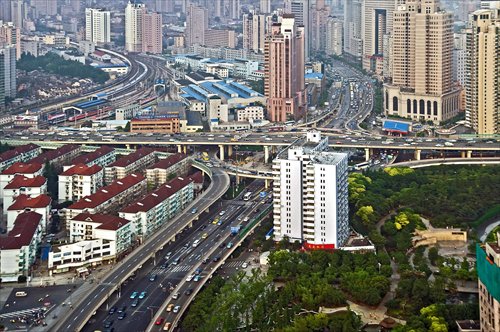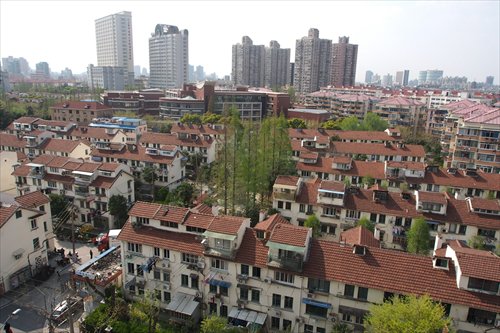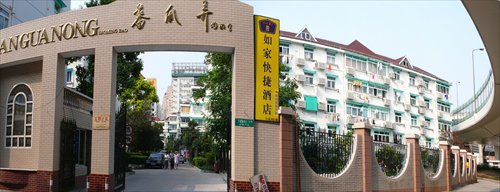HOME >> METRO SHANGHAI
The real village people
By Xie Jun Source:Global Times Published: 2015-4-8 18:28:01
Housing for workers produced new architectural styles in the city

The Fangua Lane neighborhood (red roofed) stands surrounded by high-rises and elevated roads. Photo: CFP
Shanghai's landmark architecture is more than the churches, shikumen (traditional Shanghai-style houses with stone gates) or the exotic building clusters of old Shanghai located near the Bund that most people would think of. In fact some of Shanghai's most distinctive architectural styles include the unique housing created by the authorities in 1950s and 1960s for workers. These "new workers' villages" were cultural landmarks that changed the look and outlook of the city then and still affect life today.

Caoyang New Village, China's first workers' village, is the inspiration for generations of workers. Photo: IC
The first workers' village
After 1949, inspired by the "Soviet Union model," the Chinese government focused on industrialization as the major goal of economic development. As a result, the number of factory workers mushroomed in Shanghai. Most of them had to contend with extremely poor living conditions because of the severe shortage of housing.
In 1950, Chen Yi, the then mayor of Shanghai, announced that China's economic situation had started to improve, and the pay and welfare of factory workers had to be taken care of. Two years later, China's first factory workers' neighborhood, the Caoyang New Village, was built in Putuo district. About 1,000 workers and their families moved into the village.
The layout of the Caoyang New Village was not a copy of the Soviet Union style, but was based on the "neighborhood unit" idea proposed by US architects in the 1920s. At least 10 percent of the village land was set aside for public space or parks. In the middle of the village was a primary school and the apartment buildings and ancillary facilities were set within a radius of 200 meters of the school. Villager residents could easily get access to the facilities with an eight-minute walk.
The Caoyang New Village was constructed with community amenities that could match today's commercially designed neighborhoods. The Caoyang New Village had two parks, two hospitals, a workers' cultural palace, a youth activity center and a cinema. The village was abundantly planted with trees and in summer the temperature in the village was several degrees lower than outside.
Although the homes in the village were small and comparatively cramped, they were welcomed and described as being of great significance to the working class, as they signaled respect and care from the authorities.
The first 114 residents who moved into the village were mostly model workers in their factories. A factory slogan of the day - "the entire factory is proud of anyone who moves into the village" - illustrated the emotional involvement of the society of the day, an involvement that has inspired several generations of residents in the village.
The Minhang street neighborhood
At the end of the 1950s, the Shanghai government built the Minhang street neighborhood, the Zhangmiao street neighborhood and Fangua Lane - "the two streets and one lane" project as it was known at the time.
The Minhang street neighborhood was completed just before the National Day, 1959. Compared with the workers' villages in the early 1950s, the Minhang street neighborhood was better designed and constructed, with each 20-square-meter apartment having its own bathroom.
While in the early 1950s workers' villages were essentially built just to provide accommodation for workers, in the Minhang street neighborhood, the design specifically catered for the inhabitants and their lifestyles. The ground floors of the apartment buildings were rented out to small retailers, to meet the living and leisure needs of the residents. There were also green areas and parks scattered through the neighborhood. It was, by all standards, a stylish "neighborhood" for the time.
Most of the buildings in the workers' villages in the 1950s had traditional roofs in the style of the tilted roofs of Chinese temples, but the buildings in the Minhang street neighborhood had flat roofs because the project architects wanted to be "modern." Around 2000, however, the roofs were rebuilt in the temple style which looked better and offered inhabitants less chance of encountering leaks.
The Minhang street neighborhood attracted a good deal of attention and foreign dignitaries and prominent Chinese leaders including Soong Ching Ling, Liu Shaoqi and Nie Rongzhen, inspected the project. It became one of Shanghai's landmarks.

Today's renovated Fangua Lane neigborhood Photo: IC
Seven lanes and eight streets
The reconstruction of Fangua Lane in a shanty town in Zhabei district was another approach to residential building of the period. Located in the center of Zhabei, Fangua Lane, one of the largest slums in old Shanghai, had become notorious because of its vile conditions. After 1949, most of the residents here were transport workers and women cotton mill workers. In 1965, the Shanghai government spent 5 million yuan ($806,000) redeveloping the area.
Initially the Shanghai government considered three options: transforming the area into a green space, making it a storage area or turning it into a residential neighborhood. Eventually it was marked for redevelopment as a residential neighborhood.
The reconstructed Fangua Lane was laid out along seven lanes and eight streets. Each house in the neighborhood was about 30 square meters and every two or three families shared a kitchen and bathroom. The neighborhood also offered ground-floor shops, kindergartens, public showers and tiger stoves shops (the traditional shops that sold hot water). Although these apartments were not spacious by today's standards they were a huge improvement for many of the residents at the time.
Baosteel New Village
After the "two streets and one lane" style of development, two of the most typical neighborhood villages for workers were the Jinshan Petrochemical New Village built in 1973 and the Baosteel New Village, which was completed in 1978. The villages were built to meet the housing needs of workers in the Baosteel factory and the Jinshan Petrochemical plant.
The Baosteel factory and Jinshan Petrochemical plant were new industrial complexes built in the suburbs of Shanghai, a considerable distance from the city center where most workers lived at the time. To cut workers' commuting times and solve accommodation problems, the local government built this village near the industrial area. The apartments in the village offered spacious quality accommodation and many of the workers moved there.
As well as apartment buildings, other facilities were included in the village, including hospitals and a cinema. A hotel was also opened to serve the needs of visiting experts who went to the factories to inspect and advise.
Qiaohui houses
Qiaohui houses and neighborhoods were specially designed for Chinese who had returned home from living overseas. In the 1980s they were able to buy housing that ordinary Chinese couldn't afford. One of the earliest Qiaohui buildings is the Yandang building on Yandang Road near Fuxing Park. It was funded by a Hong Kong businessman.
As well as Qiaohui houses, Waihui houses (foreign exchange houses) also emerged in Shanghai. Waihui houses were aimed at Shanghai residents who had foreign currency.
But soon after these styles showed themselves, the real estate market in Shanghai opened up and local residents started to purchase their own houses.
Changing times
After 1949 many of these neighborhoods grew in status from when they were first built. After the reform and opening-up policy was introduced, many commercial and residential buildings sprang up in the Fangua neighborhood. Later the early residents in the neighborhood all moved out, and now the area is populated by workers from outside of Shanghai.
Today, apart from some migrant tenants, only elderly residents choose to live in the Caoyang New Village. They have elected to stay in the neighborhood because they are emotionally attached and probably also because they cannot afford to move elsewhere. In their hearts they would love to see Caoyang village modernized and offering better facilities for the residents.
There will be changes at the Caoyang village but they will be gradually introduced. Modern facilities like wheelchair access, banisters, and public seats will be added. The local neighborhood committee plans to expand community services with help from nearby schools and hospitals to bring new life to this landmark village.
Compiled by Xie Jun based on a report in The Paper
Posted in: Metro Shanghai, City Panorama